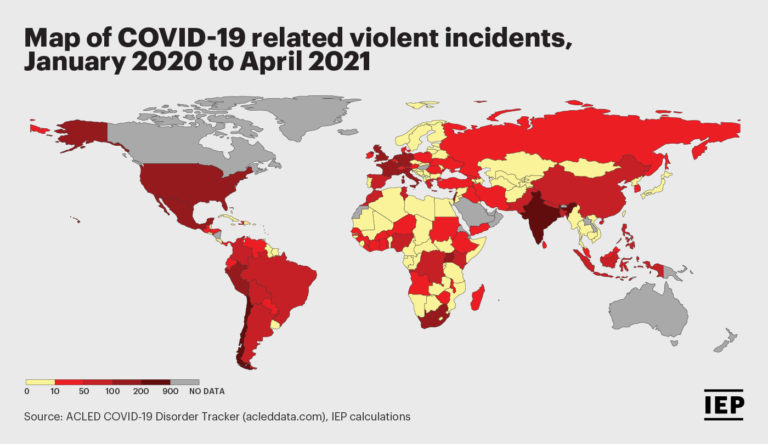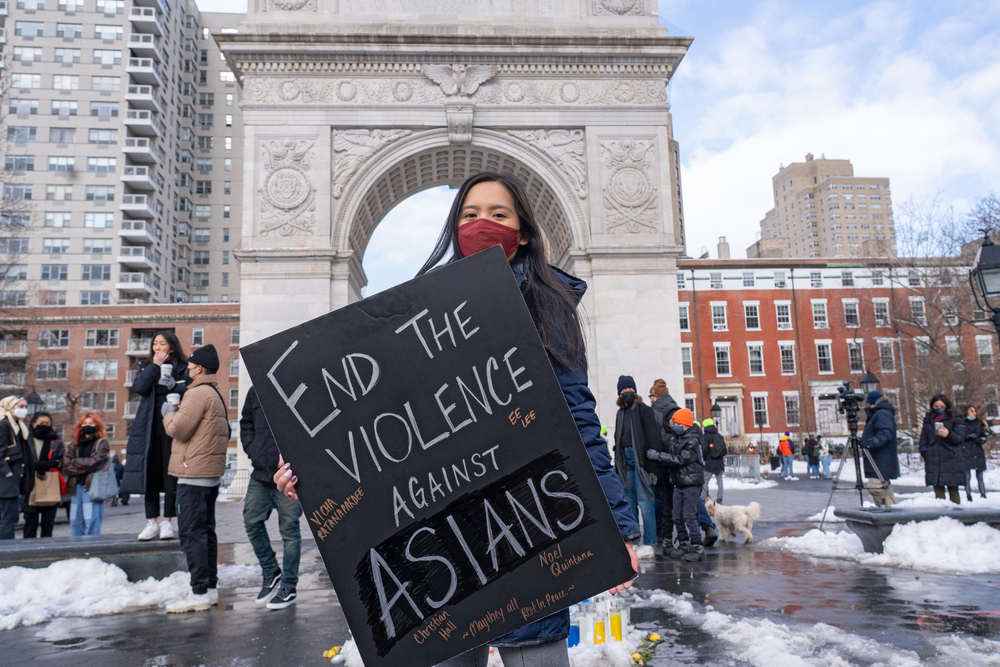While it was initially thought that the pandemic would actually reduce violence around the world, this proved to be true for only some indicators of violence. Although key indicators of internal conflict did decrease in 2020, the impact of the pandemic on active conflicts was short-lived, and the total level of political and civil unrest rose in 2021.
There were over 5,000 pandemic-related incidents between January 2020 and April 2021 that involved some form of violence, ranging from violent demonstrations and riots in response to lockdown measures, to physical assaults targeted at people of Asian descent. There were at least 158 countries that recorded one or more violent incidents directly related to the pandemic during this time.
Violent events related to the pandemic peaked in April 2020. However, although the number of events had declined significantly by August of the same year, the number of violent events per month has remained consistent since that time. There was an average of 200 violent pandemic-related events per month from August 2020 to April 2021. There were also 805 pandemic- related fatalities from January 2020 to April 2021.
While COVID-19 had the biggest impact on civil unrest and political instability, it also had a significant impact on feelings of safety and interpersonal violence.

Although there was an initial fall in civil unrest and demonstrations at the start of the pandemic, the number of demonstrations worldwide surged after this initial lull. The total number of protest events worldwide increased in 2020, and although not every demonstration was directly related to the pandemic, it was a key driver of civil unrest across many countries, most notably in Europe.
In the Netherlands, the government imposed a curfew which sparked riots described as the worst in more than 40 years.10,11 In one instance, protestors used a pipe bomb to damage a COVID-19 testing centre.12 Spain, Italy, Germany and Ireland also saw violent anti-lockdown demonstrations in which protesters threw objects at police, broke storefront windows, set bins on fire and ignited smoke bombs.
Not every pandemic-related demonstration has had an anti-lockdown motivation. In some countries, a perceived lax response from governments to the pandemic became the trigger for anti-government demonstrations. In Belarus, the government’s refusal to acknowledge the severity of the COVID-19 pandemic and subsequent impact on the healthcare system was a key driver of civil unrest. Likewise, riots broke out in Chile after a swift rise in the unemployment rate. In Lebanon, the lack of sufficient economic support from the government was one of the key drivers of unrest.
Although data for homicide and violent crime in 2020 is only available for a select number of countries, the same pattern has been observed across a number of regions. There were sharp reductions in homicide and street level violent crime, such as robbery in the immediate aftermath of lockdown measures in Colombia, Guatemala and Honduras. Smaller falls were observed in a number of European countries, and the number of homicide victims in South Africa fell by almost 50 per cent, and by almost 80 per cent in Kazakhstan. However, in most countries the number of homicides per month returned to the same level as previous years once lockdown measures were relaxed. In Mexico, crimes typically associated with people’s everyday movements, such as robberies, assaults, kidnappings and extortion, all experienced notable improvements in 2020.
Not every country saw drops in homicide and violent crime. In Mexico and Brazil, lockdowns did not have a significant impact on the number of homicides, with the number of homicides per month falling only slightly. In Chile there was an initial drop in the number of homicides, which was quickly followed by a sharp increase in the six months after lockdown measures were brought in.
Read more: Crime rates during COVID
The exact impact of the pandemic on suicide is unclear. However, it has clearly exacerbated many of the risk factors for suicide such as social isolation and financial stress. Unemployment is associated with a twofold to threefold increase in the risk of suicide and changes in levels of unemployment are often accompanied by corresponding changes in the suicide rate. However, there is often a short-term decrease in suicide following a disaster, followed by an increase in the suicide rate. This pattern appears to be holding in countries like Japan, where the suicide rate has begun to increase after initially decreasing. Other indicators of increased suicide risk have seen large increases. In the US, calls to crisis hotlines increased by 891 per cent from 2019 to 2020.
The full impact of the pandemic on suicide may not fully subside for years or even decades. It is estimated that suicide rates may persist at 25 per cent above their pre- pandemic levels for many years to come, although this will be affected by the strength of the economic recovery. In other disaster situations, long-term increases in depression and anxiety for strongly affected populations have persisted for decades.

There has been a sharp increase in violent crime targeting the Chinese diaspora and other people of Asian descent as a result of the pandemic. The attacks have ranged in severity from verbal harassment, vandalism, spitting to physical assault. In Vancouver, there was a 717 per cent increase in recorded hate crimes from 2019 to 2020, with a third of Chinese-Canadians reporting that they had been physically harassed during the pandemic. In Australia, nearly 85 per cent of Asian-Australians reported at least one instance of discrimination throughout 2020. Overt anti-Asian sentiment also surged on social media platforms over the past year.
Although the pandemic has primarily led to an increase in discrimination targeted at Asians, reports are emerging that other minority groups are becoming the victims of hate. For example, in India and Sri Lanka, Muslims are increasingly becoming targets of COVID-19 discrimination. Likewise, in China, many Africans have been forcefully evicted or forced to self-isolate and quarantine, while individuals belonging to other ethnic groups have not.
There have been significant increases in domestic violence across a number of countries following the implementation of pandemic-related lockdown orders.38 The implementations of lockdowns and other restriction of movement policies have meant that victims and perpetrators have remained in close proximity for extended periods of time, with victims cut-off from support services. It is estimated that 243 million people experienced domestic violence in 2020.
The exact extent to which domestic violence has increased is difficult to assess. Some indicators of domestic violence such as emergency room admissions decreased, as visiting healthcare facilities became more difficult owing to movement restrictions. By contrast, calls to domestic violence helplines increased by 20 to 50 percent in many countries, with internet searches related to domestic violence support services also increasing. This pattern of increasing domestic violence mirrors the trend often seen in the wake of large scale catastrophes such as bushfires, earthquakes, or hurricanes.
Closing thoughts
In 2020, humanity faces one of the most serious crises in recent history. The pandemic has shaken our global socio economic system. The tragic loss of life and deep economic disruption caused by the COVID-19 pandemic will permanently change society and economies. Responsiveness and adaptability will determine which countries perform best through this period. The pandemic will undo many years of socio-economic development for several countries, exacerbating humanitarian crises and potentially aggravating unrest and conflict. Most of the indicators of the Global Peace Index and the Positive Peace Index are likely to be negatively impacted by the COVID-19 pandemic.
The COVID-19 and Peace report produced by the Institute of Economics and Peace (IEP) outlines the global impact of the pandemic, using economic data and forecasts available as of May 2020. It discusses the changes in socio-economic systems using the Positive Peace framework and considers the repercussions of such changes on patterns of violence and conflict. Finally, it examines key aspects of the post pandemic world and comments on forward-looking initiatives to reshape the global economy. The report also analyses which countries are best positioned to deal with the crisis and those that are not.
Download the Covid-19 and Peace report.